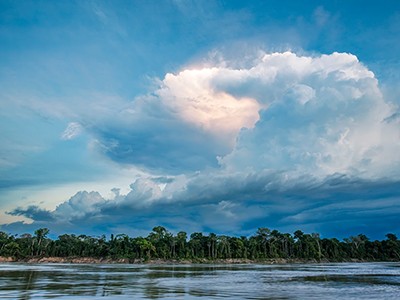Each year, I take my environmental-law students on a swamp walk in Big Cypress National Preserve in the western Everglades in Florida. Hip-deep in the translucent water, and mindful of alligators, we appreciate the cathedral-like setting inside a cypress dome. The trip helps the students to understand aquatic ecosystems and how wetlands influence downstream waters. Wetlands provide a range of ecosystem services related to water quality, flood control, aquifer recharge, shoreline stabilization and species habitats. A broader lesson is that environmental law, to be effective, must take science into account.
Sadly, the US Supreme Court’s recent ruling in Sackett v. Environmental Protection Agency demonstrates that a majority of the justices never learnt that lesson. The case has eviscerated federal protection of wetlands under the Clean Water Act, the principal federal law responsible for the improvement of the country’s water quality over the past 50 years. Before it, for example, oil and debris in the Cuyahoga River in Ohio frequently caught fire.
The court’s decision is dire, but state and local governments still have the power to defend wetlands. There has never been a more important time for scientists and the public to champion state and local wetland protection, wherever they live.
The extent and drivers of global wetland loss
Signed in 1972, the Clean Water Act has prohibited discharging pollutants into “waters of the United States” or filling them in, unless a permit is granted. The issue in the Sackett case was whether, and to what extent, wetlands are “waters of the United States” and thus protected.
The court quashed clean-water protections twice. First, it declared that the Clean Water Act applies to wetlands only when they have a continuous surface connection to a permanent body of water, such as an ocean, river, stream or lake. Wetlands connected to other bodies through groundwater are excluded, as are seasonal wetlands, such as vernal pools and playa lakes. By some estimates, this requirement wipes out Clean Water Act coverage for more than half of the nation’s wetlands. The cypress dome that my students and I visit dries up from March to May, except for some isolated holes dug by alligators. The Clean Water Act no longer protects it.
Second, and worse, the court decreed that, to qualify as a water of the United States, a wetland must be so inseparably bound to an ocean, river, stream or lake that it is “difficult to determine where the ‘water’ ends and the ‘wetland’ begins”.
This requirement has no basis in law or science. As my colleagues and I explained in a brief submitted to the court on behalf of 12 scientific societies, wetland researchers can almost always determine where a body of water ends and a wetland begins. Typically, wetland vegetation begins at a certain water depth, easily visible to wetland scientists and consultants. It is hard to identify any wetland that could pass this requirement, other than some tidal wetlands and perhaps wetlands within the high-water mark of a river. Most of the wetlands in Everglades National Park — designated by the United States as being of international importance under the Ramsar Convention, the 1971 international wetland-protection treaty — can be delineated, and thus are no longer protected by the Clean Water Act.
Why we need a new economics of water as a common good
This means that a federal permit is no longer needed to fill in most US wetlands. Projects that were denied because of their expected negative environmental consequences will now be able to proceed. Because there is no need for a permit, there is now no federal requirement to offset the adverse impacts of the loss of these aquatic resources.
With each wetland that is filled, people’s water quality will suffer, municipalities’ risks of floods will increase and habitat for wetland-dependent species will be eliminated.
The court ignored not just science, but also the intent of Congress — which specifically included wetlands adjacent to larger water bodies when it amended the Clean Water Act in 1977 — and the policies of presidential administrations from Gerald Ford to Joe Biden. Even the most restrictive view of the geographic scope of the Clean Water Act, put forth by Donald Trump’s administration, was too broad for this court.
Congress could correct the error through legislation that more clearly defines which wetlands are federally protected. Given the current political divisions, however, it is unlikely that Congress will act quickly, if at all.
Wetland protection is therefore in the hands of state and local governments. Although some states, such as California and Maryland, have their own robust wetland-protection laws, most — including large, populous ones such as Colorado, Georgia and Texas — do not. Some states have tethered their regulatory programmes to the federal programme — so, when federal jurisdiction shrinks, so will state jurisdiction.
Now is a crucial time for scientists and the public to educate state and local decision makers about how acutely we need wetlands. Scientific societies and organizations such as Engineers and Scientists Acting Locally can identify opportunities to influence policy. I hope that many scientists (and others with an appreciation of science) will seek appointment to zoning boards or run for state, county or local political office, which groups such as 3.14 Action, based in Washington DC, train scientists to do. Otherwise, developers will be free to destroy wetlands without heeding the benefits they provide to people and nature.
Competing Interests
R.C.G. was the pro bono Counsel of Record for the Amici Brief of Scientific Societies (American Fisheries Society, American Institute of Biological Sciences, Association for the Sciences of Limnology and Oceanography, Coastal and Estuarine Research Federation, Ecological Society of America, Freshwater Mollusk Conservation Society, International Association for Great Lakes Research, North American Lake Management Society, Phycological Society of America, Society for Ecological Restoration, Society for Freshwater Science and Society of Wet Scientists) submitted to the US Supreme Court in Sackett v. Environmental Protection Agency.






More News
Author Correction: Bitter taste receptor activation by cholesterol and an intracellular tastant – Nature
Audio long read: How does ChatGPT ‘think’? Psychology and neuroscience crack open AI large language models
Ozempic keeps wowing: trial data show benefits for kidney disease